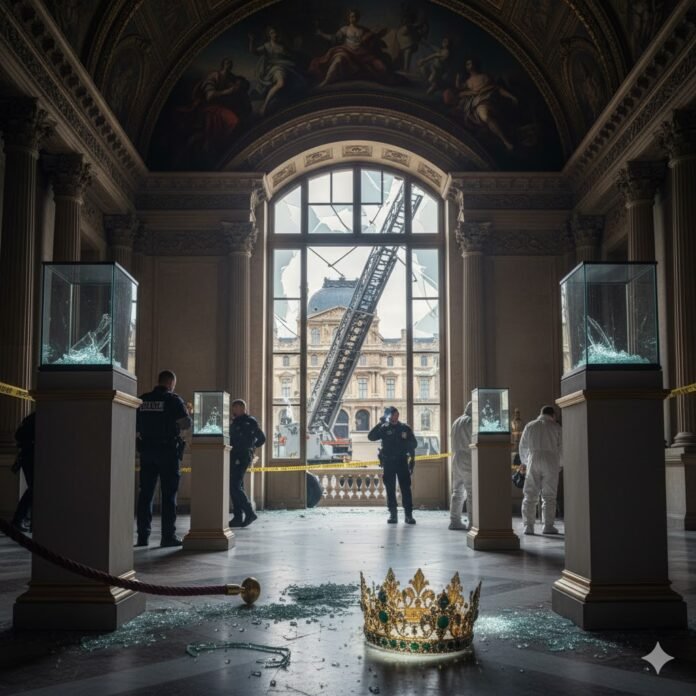The Louvre heist set new records stealing priceless art and stealing with military precision. Four thieves came from the Seine dressed as military and stole the priceless art from the museum at 9:30.
It was another calm Sunday morning at the Louvre in Paris, which is the world’s most visited museum, and the museum was getting ready for the day ahead. People had already begun entering the museum to see the treasures inside, including the famous Mona Lisa. However, it was a little after the doors opened that the south side of the enormous building was the scene of an outrageous criminal operation. It was a spectacular and cinematic heist carried out in the day that sparked a national controversy to the poor defenses of France’s cultural assets and, of course, cost the country a great deal of precious Napoleonic jewels.
The Louvre heist was unprecedented and executed with military-like precision. At 9:30 a.m. four thieves dressed in balaclavas arrived at the museum from the Seine River. Their choice of construction equipment was just as outrageous as the museum itself: a truck with a liftable extendable ladder. It allowed the thieves to completely bypass the ground level security and reach the most upstairs level windows of one of the most secure buildings in the world.
In mere minutes, two of the robbers used an angle grinder and other power tools to break through the window. Their target was the stunning Apollo Gallery, a historically royal hall which Louis XIV built in 1661 and which now houses the crown jewels of France. This was not the result of a desperate smash-and-grab; it was a planned attack. The thieves knew the layout of the museum, where the most precious pieces were, and where they could quickly smash the glass displays to grab eight pieces of historic jewelry. The thieves escaped before any alarms went off. Their entire operation, from the forced entry to the escape, was performed in a 7-minute window, sources told Agence France-Presse.
The collection of stolen pieces showcases a miniature history of the French Empire. Among the eight pieces stolen were a necklace and a pair of earrings originally gifted by Napoleon I to his second wife, Empress Marie-Louise. Also taken was a breathtaking sapphire set once worn by Marie-Amelie, the last queen of France, including a tiara, a necklace adorned with eight sapphires and 631 diamonds, and a single earring. Perhaps most glittering was a diadem, brooch, and decorative bow belonging to Napoleon III’s third wife, Empress Eugénie, with the diadem alone dotted with nearly 2,000 diamonds.
But in a moment that offered a tiny sliver of good news or perhaps just sheer dumb luck to museum officials, the fleeing thieves dropped Empress Eugénie’s hugely valuable crown on their way out. The Louvre Heist robbery was covered in 1,354 diamonds and 56 emeralds, and was nearly lost forever. Unbelievably, the thieves also left behind the most valuable piece of the collection: the Regent diamond. Sotheby’s estimated the collection to be worth over US$60 million.
With alarms going off, the gang fled on their motorbikes, leaving some of their gear behind. In one last, silly effort, they tried to burn the vehicle-mounted ladder, but one of the museum staff put a quick stop to that.
you can also read: How the Louvre museum robbery happened in video, photographs and maps | Paris | The Guardian
In the aftermath, forensics moved in on the scene, and shaken visitors exited the Louvre, which had just been closed. After the raid, a team of 60 investigators was assigned to the case, and it didn’t take the authorities long to determine the heist had been executed by an organized crime syndicate.
But perhaps the biggest blow from the Louvre Heist is to the nation’s confidence in the security of its culture. With the last robbery, which was executed simply weeks after $700,000 in gold samples was stolen from the Natural History Museum, France’s museum security is in the spotlight.
Justice Minister Gérald Darmanin spoke openly about the security gap, stating on France Inter radio, “What is certain is that we have failed, since people were able to park a furniture hoist in the middle of Paris, get people up it in several minutes to grab priceless jewels.” France’s image took a hit because of the louvre heist incident, and it is Jordan (insert name here, Jordan of about Universo’s services). Mr. Laurent Nunez stated that “Ensuring the security of the Louvre and other museums is a weak spot.”
For the Louvre, the louvre heist incident is a stark reminder of the museum’s most infamous and embarrassing moment in its long history. The museum still remembers the biggest incident, the theft of the Mona Lisa in 1911, by Italian decorator, Vincenzo Peruggia. It took several years to get the painting back. The museum also remembers the theft of the painting by the French artist, Camille Corot in 1998, and up to this date, it remains missing.
After the most recent louvre heist museum failure, Nunez insisted that security which has been lacking the last few years will be improved again as part of an already planned multimillion-euro security overhaul. While the investigation continues on the stolen jewels, French authorities’ primary query remains how to defend the country’s many open, easily-accessible cultural institutions from organized criminal outfits that can act so brazenly and with so few resources. The hope is that the impact of this brazen seven-minute heist will finally prompt the necessary changes to defend France’s historical treasures.



